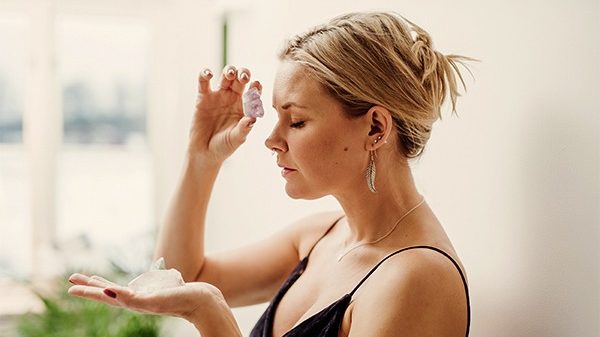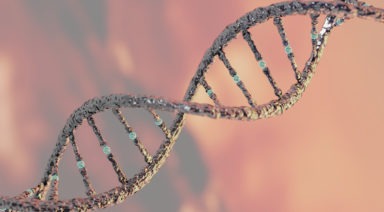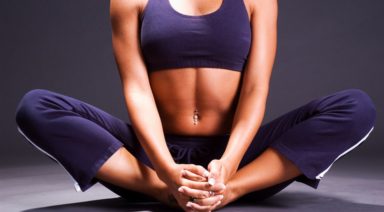7 Chakras: What You Need to Know About Chakra Alignment

Chakra comes from the Sanskrit word for wheel and is more commonly translated to mean a point of physical or spiritual energy in the human body.
If you picture yourself sitting cross-legged in Lotus pose, the 7 chakras are located on one’s body from the top of one’s head to the base of one’s spine. Each chakra has a specific location and several unique attributes. While they are aligned with the physical body, they are not something you can touch, but are something you can feel and sense.
One thing that most people don’t realize is that your chakras can both be too closed or too opened. Leaving your chakras too open or vulnerable is just as unhealthy as having closed chakras. As you read the descriptions of the 7 main chakras below, be thinking about how they relate to you.
A few years ago, I had digestive issues that modern medicine couldn’t tackle. As it turns out, my Manipura chakra was blocked. A blocked chakra can often be the cause of health or emotional issues; therefore, it is important to be conscious of the healthy of each chakra before it becomes a more serious or chronic condition.
Root Chakra
A.K.A. THE MULADHARA
Located at the base of the spine, this chakra is all about being grounded and connected to the universe.
Signs of a balanced root chakra include feeling grounded, having healthy kidneys, and lacking adrenal issues.
Once you have established that you have a weak or overactive chakra, try a combination of these techniques to realign that specific chakra:
- Apply myrrh or cedarwood essential oils to your wrists or lower back before going to sleep
- Cook with cloves and marjoram and enjoy these root chakra foods.
- Meditate with the mantra Lam
- Concentrate on these positions in your yoga practice: Grounding into feet poses like Mountain Pose, Side-Angle Pose, Warrior Pose, Standing Forward Bend, and Bridge Pose
SACRAL CHAKRA
A.K.A. THE SVADHISHTHANA
Located just below the belly button, this chakra is related to sexuality, pleasure, and emotions.
Signs of a balanced sacral chakra include healthy reproductive organs and sex hormones Other signs of sacral chakra health include feeling friendly, sexual and satisfied. It is thought that this chakra is closely related to basic emotions, so the more you are in touch with this chakra, the more you are in touch with your emotions.
Aligning techniques:
- Apply jasmine or ylang slang essential oils first thing in the morning or at night
- Meditate with the mantra Vam
- Concentrate on these positions in your yoga practice to Clear the Sacral Chakra: Hip opening poses like Standing Wide Forward Bend, Sitting Wide Forward Bend, Bound Angle Pose, and Supine Bound Angle Pose
NAVAL CHAKRA
A.K.A. THE MANIPURA OR SOLAR PLEXUS
Located above the navel, this chakra related to personal power, fears, and anxiety.
Signs of a balanced chakra include a healthy digestive system and adrenal glands.
Aligning techniques:
- Apply rosemary, ginger, or lemon essential oils to your wrist
- Drink herbal, preferably decaffeinated, tea with lemon and ginger (this one is my personal favorite!)
- Meditate with the mantra Ram
- Concentrate on these positions in your yoga practice: Heat building poses like Sun Salutation and Warrior, backbends like Bow, twists like Half Twist, and of course abdominal strengtheners like Boat Pose
HEART CHAKRA
A.K.A. THE ANAHATA
Located in the chest, this chakra relates to love and compassion.
A dear friend of mine has had a string of messy break-ups and not surprisingly she has all the signs of a blocked anahata or heart chakra. I have shared some of my clearing techniques, listed below, with her and am hopeful that given some time and work, she will open her heart and be rewarded with a healthy, loving relationship.
Signs of a balanced chakra include a strong, healthy heart, immune system, endocrine system, and good circulation. This chakra is incredibly sensitive to stress. During periods of high stress, try some of these chakra practices to balance the chakra.
Aligning techniques:
- Apply rose, bergamot, or thyme essential oils before starting your day to activate this chakra
- Mediate to the mantra Yam
- Include these positions in your yoga practice: Chest openers like Camel, Cobra, and Fish. Also breathing exercises like deep breathing and alternate nostril breathing
- Try this 30-minute yoga routine which focuses on Clearing the Heart Chakra
THROAT CHAKRA
A.K.A. THE VISHUDDHA
Located in the throat, this chakra is about communication.
When you think about this chakra, think about people in your life that may not be able to say what they are thinking or feeling. Even if they know in their mind what they would like to say, they have trouble, for whatever reason, saying their thoughts out-loud. This would be an example of having a closed vishuddha chakra. Someone who over-shares might have an unprotected or overly-open chakra.
Signs of a balanced chakra include healthy lungs and respiratory systems, and a stable thyroid hormone.
Aligning techniques:
- Apply eucalyptus essential oil at bedtime
- Meditate with the mantra Ham
- Concentrate on these positions into your yoga practice: Fish, Lion, and neck stretches and shoulder openers like Supported Shoulderstand, Camel, Bridge Pose, and Plow Pose
THIRD EYE CHAKRA
A.K.A. THE AJNA
Located between the eyebrows, this chakra is related to your intuition.
Signs of a balanced Ajna chakra include healthy eyes, head, and an in-tune intuition. In addition, this chakra is closely related to the pineal gland, which secretes melatonin. It is thought that this means healthy, uninterrupted sleep can often be found by aligning your Ajna chakra.
This is one chakra that I have been working on, because women have very strong intuitions and it is a gift we should foster. How I work on it is by lighting spearmint or jasmine candles and cooking with lots of bay and sage. Also, it is a good excuse to hold my Child’s Pose a few deep breaths longer!
Aligning techniques:
- Apply clary sage, bay, helichrysum, or jasmine essential oils to activate the chakra
- Cook with bay leaves and mint
- Meditate with the mantra Om
- Include these positions in your yoga practice: Child’s Pose and Seated Yoga Mudra
CROWN CHAKRA
A.K.A. THE SAHASRARA
Located in the crown of the head, this chakra is about a connection to the spiritual.
Signs of a balanced crown chakra include a general blissful feeling and a healthy central nervous system.
Aligning techniques:
- Realigning this chakra is best done through mediation.
- There is no mantra for this chakra, silence is suggested
- Start adding daily outdoor walks into your routine
- Apply sandalwood or lotus essential oils to activate this chakra
- Include these positions in your yoga practice: Balancing poses that bring awareness to the body and the consciousness like Tree and Eagle, also try extended sitting in Yoga Audra
There are dozens of quizzes and questionnaires online that can determine if you have a misaligned or closed chakra, but you probably already have a sense of your body and what might need some adjustments. If you’re like me, you are probably already doing some of the chakra practices and alignment techniques listed above, because they make you feel better, and now you have a better understanding of why they make you feel that way and how these actions better align your chakras.
Six Ways to Cleanse Your Aura for Spring

If we are spirits having a human experience, then it is this frequency of spirit which vibrates and creates an energetic field around the human body. This field around our physical body is known as the “aura.” Just like your physical body, your subtle body in the form of you aura may experience and exhibit stress, fragmentation, and a loss of luminosity. Spring is an excellent time to detoxify and regenerate, both body and spirit. Try these steps to cleanse your aura and liberate its highest potential and feel the cascading effects seasons after season.
How to Remove Negative Energy & Cleanse Your Aura
1. Visualize Your Aura
Sit in a quiet, distraction-free zone in your house. Stay seated comfortably in a position you can relax in for about 15 minutes while practicing breathing exercises. Remain conscious of what you’re doing, and aware of your inhales and exhales. You can even meditate. Once you find yourself beginning to totally relax, form a white light in your mind and have it surround you. Allow it to flow throughout you, from the tips of your toes to the top of your head, and visualize it moving up and down your back, near your spine. If you get distracted or thrown off, you can get yourself back on track by re-visualizing the white light and focusing on your breath.
2. Discard Your Negative Energy
Avoid negative people or energy vampires. People affect more than just themselves, so be aware of how others affect your energy and vice versa. One way to protect yourself is to make sure you surround yourself with more positive people than negative ones. Spend less time time (or none at all) with negative people, once you figure who they are. Find positive people who always have a smile to offer and have kind souls. These people can help offset negativity in your aura.
3. Cleanse Your Own Negative Thoughts
Still have negative energy wafting around? Try looking inward. Start paying attention to your thoughts. Are there a lot of negative ones? Take a look at them. Are they untrue, delusional, or paranoid? All the more reason to chuck them out. Focus on the bright side of things. If you are having a really bad day, it’s okay to express your feelings, but don’t wallow in that place. Make your day a good one by treating yourself to your favorite tea. Play your favorite song. Find a friend to hang out with. If you notice that a negative thought is trying to creep in, confront it with a positive one. If you keep practicing this, you will be able to conquer the effects of negative thinking.
4. Create a Protection Bubble
This is the most commonly practiced ways of protecting the aura. Practitioners praise it as a beautiful way to connect them to the divine energy, and when it’s done in the mornings, it’s a defining start to the day. Imagine white light coming down from the sky, divine, cosmos, universe, whatever higher power resonates with you. Connect this light to the crown of your head, and then let it spill out over you and down under your feet. You are now surrounded by a white light bubble. White is pure and highly protective. You are in control of what enters and exits your white bubble of protection.
5. Get Energy Healings
Sometimes you just need a realignment: energy healings can help clean blockages or balance misalignments. Healers also check for negative entities or emotional cords that may need to be cut. Don’t underestimate the power of these energy checkups. You might find that your mood swings and imbalanced emotions improve drastically with a little help.
6. Smudge Your Aura Regularly
Smudging is a Native American practice using white sage to cleanse any negative energy. You can cleanse your house, people and things. Try smudging after you’ve had a lot of people in your home or if you feel particularly drained. Focus your intention on clearing negative energy to allow room for positive energy in your space and life.




































